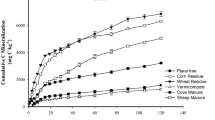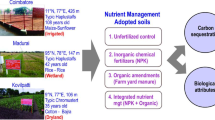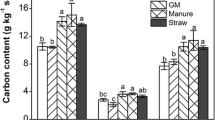Abstract
Sustainable agriculture requires the careful optimization of the use of crop residues and organic amendments to improve soil fertility. To understand the events that occur in soils after the addition of different crop residues and organic amendments, we conducted a 90-day laboratory incubation (at 28 °C with humidity fitted to 2/3 of the field capacity) to evaluate carbon and nitrogen mineralization dynamics in silty-clay soil and silty-sandy soil collected from Tunisia after adding crop residues (sulla, rapeseed, faba bean, and wheat) and farmyard manure. The present study aims to better determine the relationship between carbon and nitrogen mineralization, the chemical, biochemical characteristics, and texture of two Tunisians soils amended with crop residues and farmyard manure. The carbon mineralization rates were higher in soil amended with crop residues than that of manure. Soils amended with crop residues of rapeseed released 59.24% TOC for Benikhdech’s soil and 91.51% TOC for Mornag’s soil during the 90-day incubation, more than thrice as much as that released from soils amended with farmyard manure (15.97% TOC for Benikhdech’s soil and 23.91% TOC for Mornag’s soil). At the end of the incubation, the net nitrogen mineralization in farmyard manure-amended soils was 36.84 mg N kg−1 in the soil of silty sandy soil of Benikhdech and 64.59 mg N kg−1 in the silty-clay soil of Mornag, more than twice higher than that in soils amended with residues (rapeseed and wheat). On the other hand, mineral nitrogen rates were also higher in Fabaceae residues-amended soils. The net nitrogen mineralization was 23.01 mg N kg−1 in the soil of silty sandy soil of Benikhdech amended with sulla and 48.06 mg N kg−1 in the silty-clay soil of Mornag amended with sulla. This can be as a result of mineralization being influenced by the source, nature, chemical and biochemical composition of the incorporated crop residues and manure. In addition, soil texture had also positive effects on carbon and nitrogen mineralization evolution. Indeed, the amounts of carbon and nitrogen mineralized in silty-clay soil of Mornag were higher (P <0.05) than those in silty-sandy soil of Benikhdech throughout the incubations. However, the contribution of organic matter showed itself beneficial for both types of soils.







Similar content being viewed by others
References
Abbasi MK, Khizar A (2012) Microbial biomass carbon and nitrogen transformations in a loam soil amended with organic–inorganic N sources and their effect on growth and N uptake in maize. Ecol Eng 39:123–132
Abbasi MK, Tahir MM (2012) Economizing nitrogen fertilizer in wheat through combinations with organic manures in Kashmir. Pakistan Agron J 104:169–177
Abbasi MK, Mahmood TM, Sabir N, Khurshid M (2015) Impact of the addition of different plant residues on nitrogen mineralization–immobilization turnover and carbon content of a soil incubated under laboratory conditions. Solid Earth 6:197–205
Abiven S, Recous S, Reyes V, Oliver R (2005) Mineralisation of C and N from root, stem and leaf residues in soil and role of their biochemical quality. Soil Biol Biochem 42:119–128
Abiven S, Menasseri S, Angers DA, Leterme P (2007) Dynamics of aggregate stability and biological binding agents during decomposition of organic materials. Eur J Soil Sci 58:239–247
Accoe F, Boeckx P, Busschaert J, Hofman G, Van Cleemput O (2004) Gross N transformation rates and net N mineralization rates related to the C and N contents of soil organic matter fractions in grassland soils of different age. Soil Biol Biochem 36:2075–2087
Anderson JM, & Ingram JSI (1993) Tropical soil biology and fertility. A handbook of methods. Wallingford, UK: CAB International.
Annabi M (2005) Stabilisation de la structure d’un sol limoneux par des apports de composts d’origine urbaine : relation avec les caractéristiques de leur matière organique. Thèse de doctorat, Institut National Agronomique Paris-Grigon, France, p 280
Baldi E, Toselli M (2014) Mineralization dynamics of different commercial organic fertilizers from agro-industry organic waste recycling: an incubation experiment. Plant Soil Environ 60:93–99
Barry Y (2006) La transformation des apports organiques dans le sol (modèle TAO) : cas des apports riches en azote. Master de Recherche CGSE : Université Henri Poincaré UHP, INLP, Nancy, France
Ben Jeddi F (2005) Hedysarum coronarium L. variation génétique, création variétale et utilisation dans des rotations tunisiennes, Thèse de doctorat en sciences biologiques appliquées de la Faculté des Sciences en Bio ingénierie, Université de Gent Belgique 216
Bertrand I, Chabbert B, Kurek B, Recous S (2006) Can the biochemical features and histology of wheat residues explain their decomposition in soil? Plant Soil 281:291–307
Bouajila K (2016) Contribution à l’étude de la minéralisation des résidus de cultures et fumier de ferme dans des conditions arides Tunisiennes. Thèse de doctorat en Sciences Agronomiques, Institut National Agronomique de Tunisie INAT, p 183
Bouajila K (2017) Valorisation des résidus de cultures et fumier de ferme en Tunisie. Editions Universitaires Européennes, Tunisia, p 177
Bouajila K, Ben Jeddi F (2015) Effects of Sulla crop (Hedysarum coronarium L.) conducted in direct and conventional drillings, on the physico-chemical propreties of clay soil under Tunisian semi- arid climate. Algerian journal of arid environment-AJAE 5(1):18–31
Bouajila K, Ben Jeddi F, Sanaa M (2014) Effet de la décomposition des résidus de sulla (Hedysarum coronarium L.) sur l’évolution des caractéristiques chimiques de deux types de sol en climat aride Tunisien. J Mater Environ Sci 5(3):723–730
Cayuela ML, Sinicco T, Mondini V (2009) Mineralization dynamics and biochemical properties during initial decomposition of plant and animal residues in soil. Appl Soil Ecol 48:118–127
Diacono M, Montemurro F (2010) Long term effects of organic amendments on soil fertility. A review Agron Sustain Dev 30:401–422
Finstein MS, Miller FC, Strom PF, Rehm HJ, Reed G (1986) Waste treatment composting as a controlled system. Biotechnology 8:363–398
Freijer J, IET Bouten W (1991) A comparison of field methods for measuring soil carbon dioxide evolution: experiments and simulation. Plant Soil 135:133–142
Garten J, ET Charles T (2004) Potential net soil N mineralization and decomposition of glycine C13 in forest soils along an elevation gradient. Soil Biol Biochem 36:1491–1496
Han KH, Choi W, Han J, Yun GH, Yoo SI, SH RO (2004) Urea-nitrogen transformation and compost nitrogen mineralization in three different soils as affected by the interaction between both nitrogen inputs. Biol Fertil Soils 39:193–199
Helfrich M, Ludwig B, Potthoff M, Flessa H (2008) Effect of litter quality and soil fungi on macroaggregate dynamics and associated partitioning of litter carbon and nitrogen. Soil Biol Biochem 40:1823–1835
Hsieh YP, Douglas LA, Motto HL (1981) Modeling sewage sludge decomposition in soil: I. organic carbon transformation. J Environ Qual 10:54–59
Huang Y, Zou J, Zheng X, Wang Y, Xu X (2004) Nitrous oxide emissions as influenced by amendment of plant residues with different C :N ratios. Soil Biol Biochem 36:973–981
James PM, Korand H (1996) Influence of mineral colloids on turnover rates of soil organic carbon. Soil Sci Soc Am 17:283–302
Jedidi N (1998) Minéralisation et humification des amendements organiques dans un sol limono-argileux tunisien. Thèse Ph.D en Sciences Biologiques Appliqués à l’université de GENT Belgique 180
Jedidi N, Van Cleemput O, M’Hiri A (1993) Mineralization of organic amendements in a Tunisian soil. In: Soil organic Matter Dynamics and sustaivability of Tropical Agriculture. Edited by K, Mulongoy and R, Mercks, a Wiley- Sayce Co- Publication 163-169
Jenkinson DS (1977) Studies on the decomposition of plant material in soil. IV. The effect of rate of addition. J. Soil Sci 28:417–423
Khalil MI, Hossain MB, Schmidhalte U (2005) Carbon and nitrogen mineralization in different upland soils of the subtropics treated with organic materials. Soil Biol Biochem 37:1507–1518
Khaliq A, Abbasi MK (2015) Improvements in the physical and chemical characteristics of degraded soils supplemented with organic– inorganic amendments in the Himalayan region of Kashmir, Pakistan. Catena 126:209–219
Ladd JN, Foster RC, Skjemstad JO (1993) Soil structure: carbon and nitrogen metabolism. Geoderma 56:401–434
Le Guillou C (2011) Effets combinés de la qualité des résidus de culture et de la disponibilité en azote minéral sur la stabilisation de la structure du sol par les Microorganismes. Thèse de doctorat/Agrocampus Ouest,Université Européenne de Bretagne, France 125
Leifeld J, Siebert S, Ko¨gel-Knabner I (2002) Biological activity and organic matter mineralization of soils amended with biowaste composts. J Plant Nutr Soil Sci 165:151–159
Machinet G E (2009) Utilisation de la variabilité génétique du maïs pour évaluer le rôle de la qualité chimique des racines sur le processus de décomposition dans les sols. Thèse de doctorat, Université de Reins Champagne Ardenne, France 207
Malhi SS, Lemke R, Wang ZH, Baldev SC (2006) Tillage, nitrogen and crop residue effects on yield, nutrient uptake, soil quality and greenhouse gas emissions. Soil Tillage Res 90:171–183
Manojlovic M, Cabilovski R, Bavec M (2010) Organic materials: sources of nitrogen in the organic production of lettuce. Turk J Agric For 34:163–172
Masunga RH, Uzokwe VN, Mlay PD, Odeh I, Singh A, Buchan D, De Neve S (2016) Nitrogen mineralization dynamics of different valuable organic amendments commonly used in agriculture. Appl Soil Ecol 101:185–193
Mathieu DD, Pascal KTA, Justin YK (2011) Décomposition des broyats de coques de cacao dans les sols ferrallitiques de la zone d’Oumé, centre-ouest de la Côte d’Ivoire : effets sur les caractéristiques chimiques des sols. Biotechnol Agron Soc Environ 15:109–117
Mohanty M, Reddy SK, Probert ME, Dalal RC, Rao SA, Menzies NW (2011) Modelling N mineralization from green manure and farmyard manure from a laboratory incubation study. Ecol Model 222:719–726
Nicolardot B, Recous S, Mary B (2001) Simulation of C and N mineralization during crop residue decomposition: a simple dynamic model based on the C:N ratio of the residues. Plant Soil 228:83–103
Novara A, Gristina L, Rühl J, Pasta S, D’Angelo G, La Mantia T, Pereira P (2013) Grassland fire effect on soil organic carbon reservoirs in a semiarid environment. Solid Earth 4:381–385
Oades JM (1988) The retention of organic matter in soil. Biochemistry 5:35–70
Parnaudeau V (2005) Caractéristiques biochimiques de produits organiques résiduaires, prédiction et modélisation de leur minéralisation dans les sols. Thèse de doctorat ENSA-Rennes. 58 pages + annexes.
Quilty JR, Cattle SR (2011) Use and understanding of organic amendments in Australian agriculture: a review. Soil Res 49:1–26
Russel AE, Laird DA, Mallarino AP (2006) Nitrogen fertilization cropping system impacts on soil quality in Midwestern Mollisols. Soil Sci Soc Am J 70:249–255
Saggar S, Parshotam A, Hedley C, Salt G (1999) 14C-labelled glucose turnover in New Zealand soils. Soil Biol Biochem 31:2025–2037
Tejada M, Benítez C (2014) Effects of crushed maize straw residues on soil biological properties and soil restoration. Land Degrad Dev 25:501–509
Trinsoutrot I, Recous S, Mary B, Nicolardot B (2000) C and N fluxes of decomposing 13 C and 15 N Brassica napus L.: effects of residue composition and N content. Soil Biol Biochem 32:1717–1730
Van Veen JA, Kuikman PJ (1990) Soil structural aspects of decomposition of organic matter by microorganisms. Biogeochemistry 11:213–233
Walkley A, Black IA (1934) An examination of the Degtjareff method for determining soil organic matter, and a proposed modification of the chromic acid titration method. Soil Sci 37:29–38
Weber J, Drozd J, Licznar M, Jamroz E, Karczewska A, Liczar SE (2007) Agricultural and ecological aspects of soil fertility improvement by application of composts produced from municipal solid wastes. Geophys Res Abstr 7:13–80
Funding
All authors declare that they have no-funding for this research.
Author information
Authors and Affiliations
Corresponding author
Ethics declarations
Additional declarations for articles in life science journals that report the results of studies involving humans and/or animals.
Conflict of interest
The authors declare that they have no competing interests.
Availability of data and material
(No applicable)
Code availability
(No applicable)
Authors' contributions
(No applicable)
Ethics approval
(No applicable)
Consent to participate
(No applicable)
Consent for publication
(No applicable)
Additional information
Responsible Editor: Haroun Chenchouni
Rights and permissions
About this article
Cite this article
Bouajila, K., Chibani, R., Mechri, M. et al. Carbon and nitrogen mineralization dynamics in tow amended soils collected from the semi-arid and arid regions of Tunisia. Arab J Geosci 14, 1005 (2021). https://doi.org/10.1007/s12517-021-07417-4
Received:
Accepted:
Published:
DOI: https://doi.org/10.1007/s12517-021-07417-4




